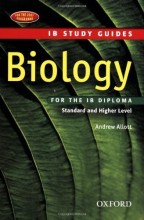Summary: Biology For The Ib Diploma : Standard And Higher Level | 9780199151431 | Andrew Allott
- This + 400k other summaries
- A unique study and practice tool
- Never study anything twice again
- Get the grades you hope for
- 100% sure, 100% understanding
Read the summary and the most important questions on Biology for the IB Diploma : standard and higher level | 9780199151431 | Andrew Allott.
-
2 Chemistry of life
-
2.1 Chemistry of life
This is a preview. There are 14 more flashcards available for chapter 2.1
Show more cards here -
What are the most frequent occurring chemicals?
- Carbon
- Hydrogen
- Oxygen
- Nitrogen
Calcium: bones
Iron: Hemoglobin
Sulphur: Amino acids
Sodium: nerves
Phosphorus: ATP
-
How is water used in living organisms?
Coolant
High specific heat capacity --> can absorb heat without significant rise in temp.Homeostasis:
maintaining a consistent internal environment eg temp
High latent heat of vaporization--> Heat energy needed to brak hydrogen bond for H2) to evaporate
-Carries heat away from body eg sweating.
Transport in plants --> cohesive properties
Allows long columbs of water to be drawn up xylem
Metabolic reactions + Transport --> solvent properties
-As water allows substances to dissolve into it and be transported e.g.. glucose in blood.
-
State one function of glucose, lactose and glycogen in animals and fructose, sucrose and cellulose in plants
Animals
- Glucose: aerobic respiration
- Lactose: milk for young
- Glycogen: carbohydrates storage
Plants
- Fructose: fruit sugar + flower nectar
- Sucrose: transport of sugar
- Cellulose: cell wall structural support
-
State the functions of lipids
- Thermal insulation
- Energy storage
- Impact protection
-
Compare the use of carbohydrates and lipids in energy storage
- Lipids have twice the energy content of carbs per unit of mass
- Carbs used for short term --> lipids long term
- Carbs stored as:
Plants--> starch
animals --> glycogen
- Carbs are more soluble than lipids : more readily converted to glucose for respiration when needed
- Lipids have less mass than carbohydrates, more effective storage
-
3 Digestion
This is a preview. There are 2 more flashcards available for chapter 3
Show more cards here -
Explain why digestion f large molecules is essential
- Digestion breaks down large complex insoluble molecules that could not pass from the digestive system to the blood
- Once large molecules are broken down they become simple soluble molecules that can easily pass from the digestive system into the blood
-
State the source, substrate, product and optimum PH for amylase, protein and lipase
Enzyme Source Substrate Product PH Amylase Slavia Starch Maltose 7 Protease Stomach cell Proteins Amino acids 3 Lipase Pancreas juice Fats lipids (tryglicerides) 7 (neutral) -
Functions of the small intestine
Digestion: all types of digestion
- Carbohydrates
- Protease
- Lipase
Absorption:
- vili
-
Function of the large intesine
- water absorption
- undigested food compacted to faeces
- bacteria which synthesize vitamin K
-
Differences between absorption and assimilation
Absorption: means taking in substances through cell membranes or layers of cells, in particular from the lumen of the gut into the blood or lymph capillaries
Assimilation: involves the conversion of nutrients into fluids or solid parts of the organism. Assimilation can ONLY OCCURE after absorption
- Higher grades + faster learning
- Never study anything twice
- 100% sure, 100% understanding
































